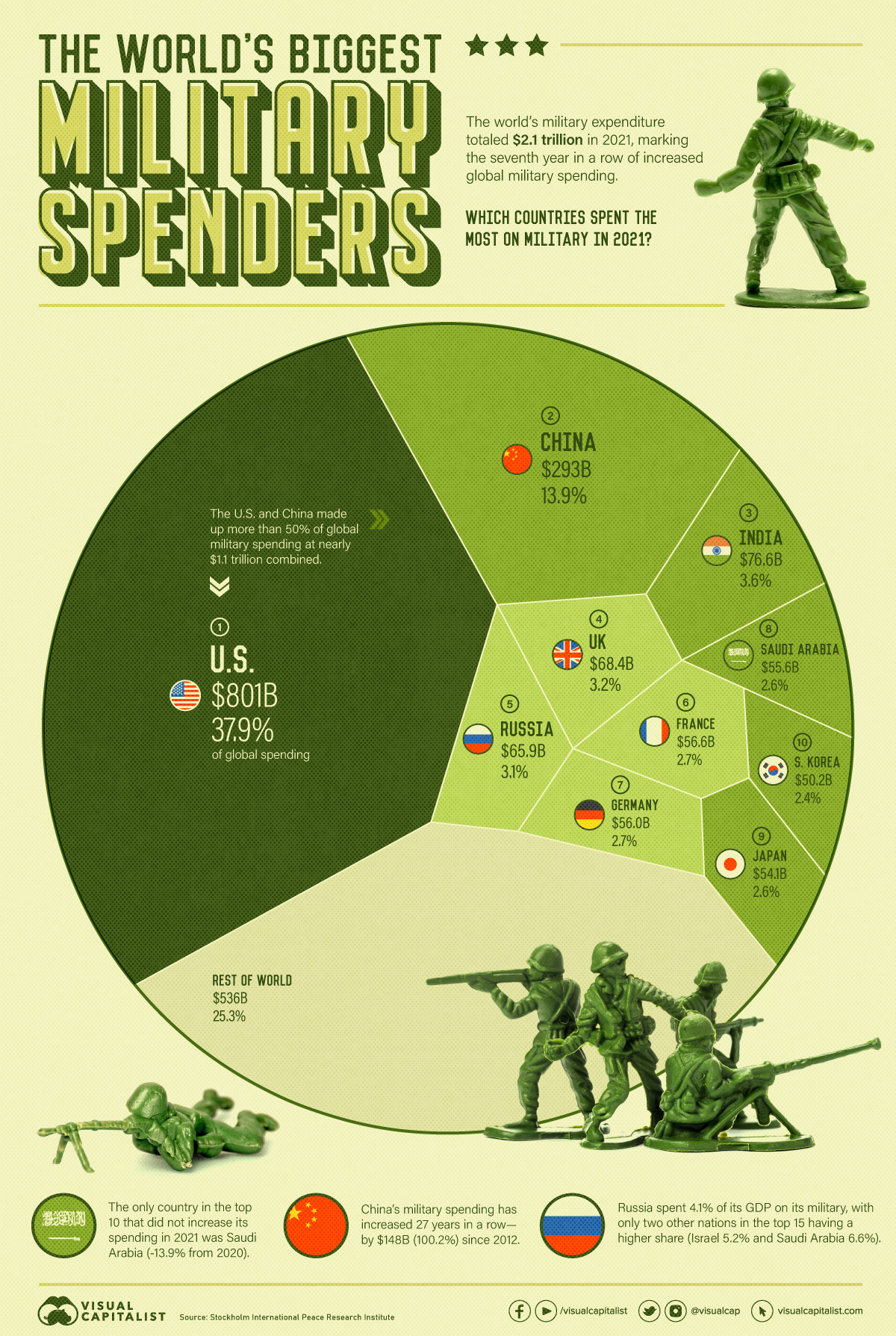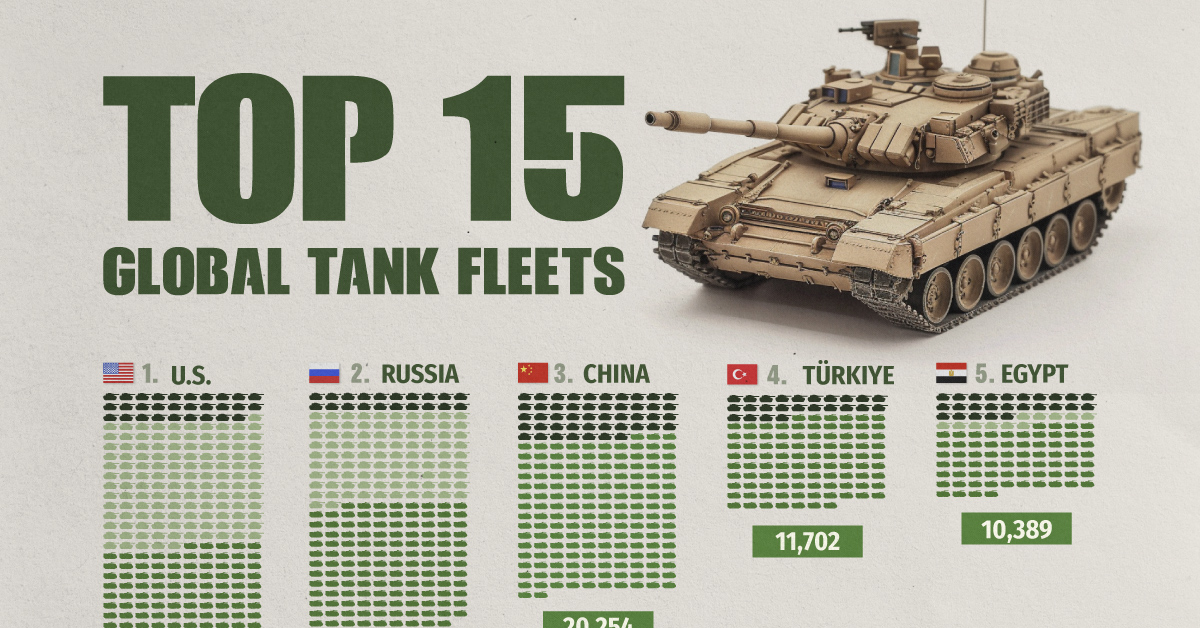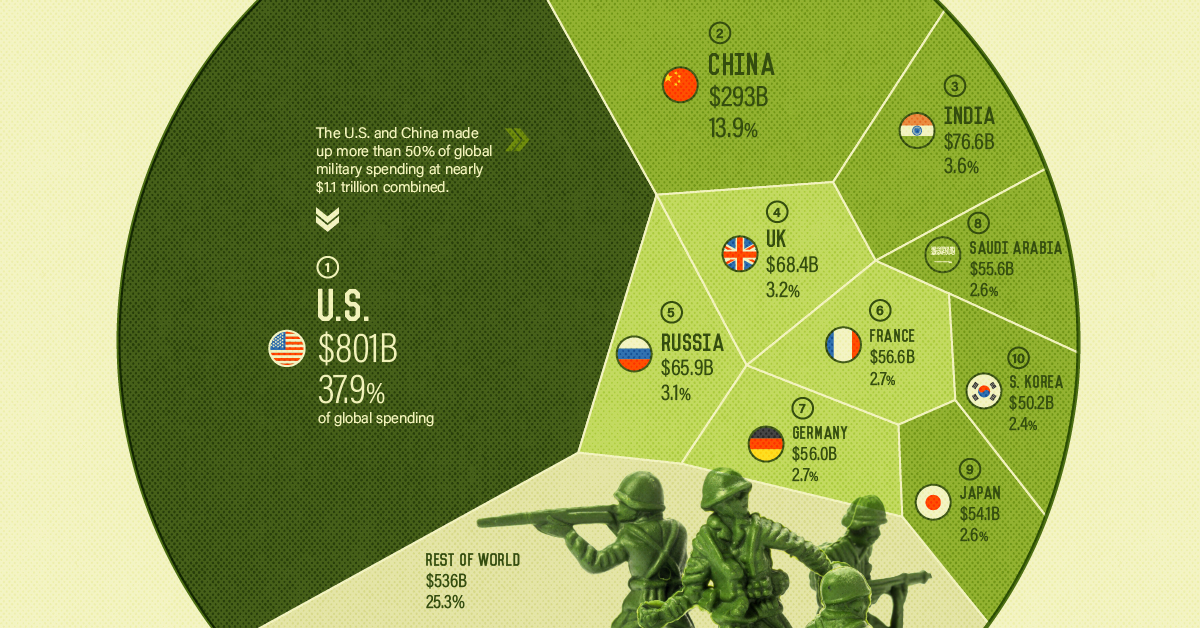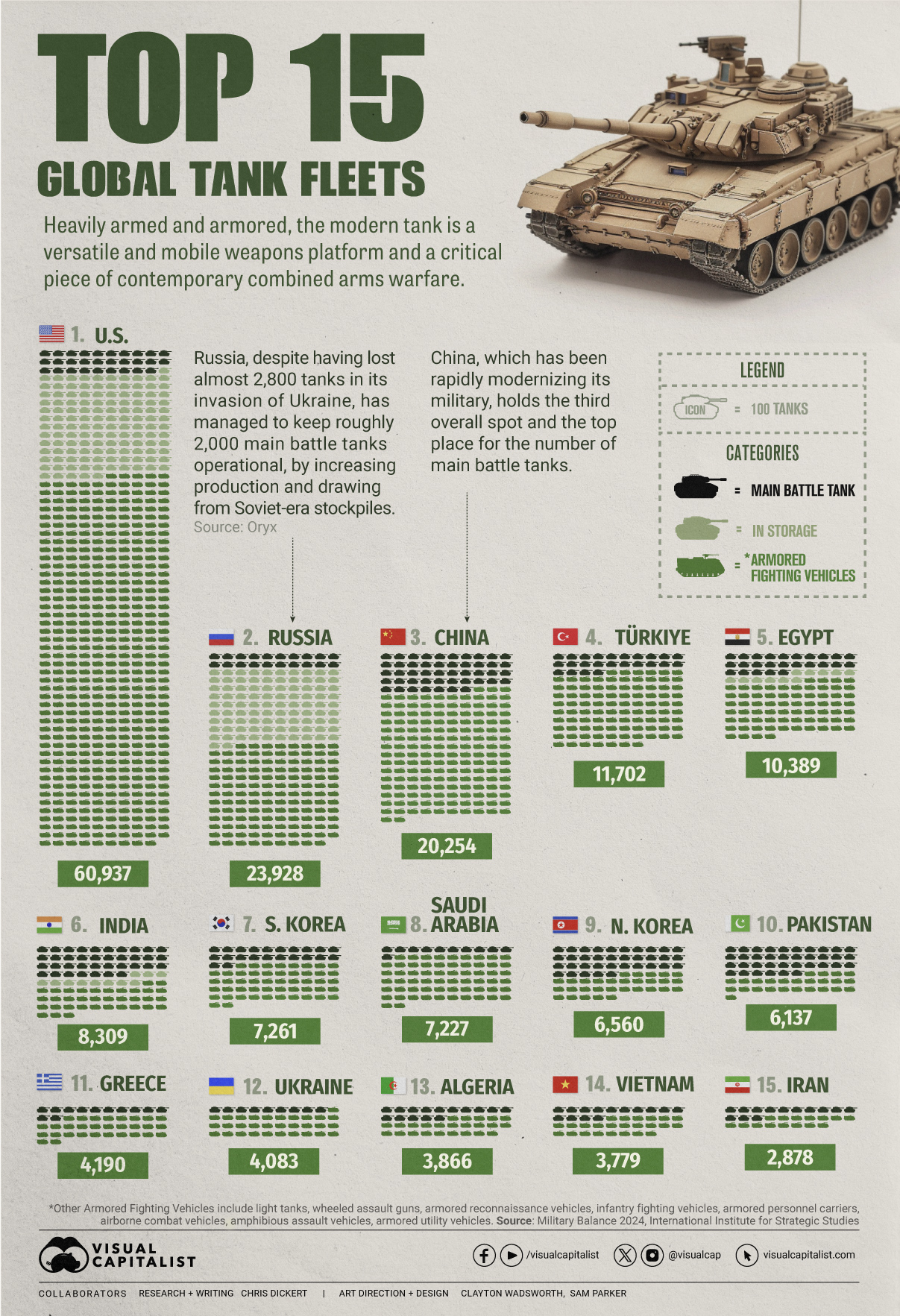War
Ranked: Top 10 Countries by Military Spending

The Top 10 Countries by Military Spending in 2021
As Russia’s invasion of Ukraine has continued, military spending and technology has come under the spotlight as the world tracked Western arms shipments and watched how HIMAR rocket launchers and other weaponry affected the conflict.
But developing, exporting, and deploying military personnel and weaponry costs nations hundreds of billions every year. In 2021, global military spending reached $2.1 trillion, rising for its seventh year in a row.
Using data from the Stockholm International Peace Research Institute (SIPRI), this visualization shows which countries spent the most on their military in 2021, along with their overall share of global military spending.
Which Countries Spend the Most on Military?
The United States was the top nation in terms of military expenditure, spending $801 billion to make up almost 38% of global military spending in 2021. America has been the top military spending nation since SIPRI began tracking in 1949, making up more than 30% of the world’s military spending for the last two decades.
U.S. military spending increased year-over-year by $22.3 billion, and the country’s total for 2021 was more than every other country in the top 10 combined.
| Country | Military Spending (2017) | Military Spending (2018) | Military Spending (2019) | Military Spending (2020) | Military Spending (2021) |
|---|---|---|---|---|---|
| 🇺🇸 U.S. | $646.8B | $682.5B | $734.3B | $778.4B | $800.7B |
| 🇨🇳 China | $210.4B | $232.5B | $240.3B | $258.0B | $293.4B |
| 🇮🇳 India | $64.6B | $66.3B | $71.5B | $72.9B | $76.6B |
| 🇬🇧 United Kingdom | $51.6B | $55.7B | $56.9B | $60.7B | $68.4B |
| 🇷🇺 Russia | $66.9B | $61.6B | $65.2B | $61.7B | $65.9B |
The next top military spender in 2021 was China, which spent $293.4 billion and made up nearly 14% of global military spend. While China’s expenditure is still less than half of America’s, the country has increased its military spending for 27 years in a row.
In fact, China has the largest total of active military personnel, and the country’s military spending has more than doubled over the last decade.
While Russia was only the fifth top nation by military spending at $65.9 billion in 2021, it was among the higher ranking nations in terms of military spending as a share of GDP. Russia military expenditures amounted to 4.1% of its GDP, and among the top 10 spending nations, was only beaten by Saudi Arabia whose spending was 6.6% of its GDP.
Military Collaboration Since the Russia-Ukraine Conflict
Russia’s invasion of Ukraine in February has resulted in seismic geopolitical shifts, kicking off a cascade of international military shipments and collaboration between nations. The security assistance just sent by the U.S. to Ukraine has totaled $8.2 billion since the start of the war, and has shown how alliances can help make up for some domestic military spending in times of conflict.
Similarly, Russia and China have deepened their relationship, sharing military intelligence and technology along with beginning joint military exercises at the end of August, alongside other nations like India, Belarus, Mongolia, and Tajikistan.
Since China’s breakthrough in hypersonic missile flight a year ago, Russia has now been testing its own versions of the technology, with Putin mentioning Russia’s readiness to export weaponry he described as, “years, or maybe even decades ahead of their foreign counterparts”.
Sanctions and Energy Exports: New Weapons in Modern Warfare
Along with advanced weaponry, sanctions and energy commodities have become new tools of modern cold warfare. As Western economic sanctions attempted to cripple Russia’s economy following its invasion, Russian gas and oil supplies have been limited and forced to be paid in rubles in retaliation.
Global trade has been turned into a new battlefield with offshore assets and import dependencies as the attack vectors. Along with these, cyberattacks and cybersecurity are an increasingly complex, obscure, and important part of national military and security.
Whether or not Russia’s invasion of Ukraine ends in 2022, the rise in geopolitical tensions and conflict this year will almost certainly result in a global increase in military spending.
War
Visualized: Top 15 Global Tank Fleets
Heavily armed and armored, the modern tank is a versatile and mobile weapons platform, and a critical piece of contemporary warfare.

The Top 15 Global Tank Fleets
This was originally posted on our Voronoi app. Download the app for free on iOS or Android and discover incredible data-driven charts from a variety of trusted sources.
Heavily armed and armored, the modern tank is a versatile and mobile weapons platform, and a critical piece of contemporary warfare.
This visualization shows the top 15 global tank fleets, using data from the 2024 Military Balance report from the International Institute for Strategic Studies (IISS).
Let’s take an in-depth look at the top three fleets:
1. United States
As the world’s pre-eminent military power, it’s perhaps no surprise that the United States also has the largest tank fleet, by a wide margin.
In total, they have just over 45,000 armored fighting vehicles in operation, along with 2,640 main battle tanks (MBTs), and 12,800 vehicles in storage, of which 2,000 are main battle tanks.
| Category | Vehicles | Global rank |
|---|---|---|
| Main battle tanks | 2,640 | 4 |
| Armored reconnaissance | 1,745 | 1 |
| Infantry fighting vehicles | 3,262 | 3 |
| Armored personnel carriers | 10,644 | 1 |
| Amphibious assault vehicles | 1,401 | 1 |
| Armored utility vehicles | 28,445 | 1 |
| Storage | 12,800 | 1 |
| Total | 60,937 | 1 |
The U.S. is internalizing the lessons from the ongoing invasion of Ukraine, where Western-supplied anti-tank weapons and massed Ukrainian artillery have been cutting Russian tanks to pieces. As a result, the U.S. recently canceled an upgrade of the M1 Abrams in favor of a more ambitious upgrade.
Meanwhile, the U.S. is nervously eyeing a more confident China and a potential clash over Taiwan, where air and naval forces will be critical. However, a recent war game showed that Taiwanese mechanized ground forces, kitted out with American-made tanks and armored fighting vehicles, were critical in keeping the island autonomous.
2. Russia
According to Oryx, a Dutch open-source intelligence defense website, at time of writing, Russia has lost almost 2,800 main battle tanks since invading Ukraine. Considering that in the 2022 edition of the Military Balance, Russia was estimated to have 2,927 MBTs in operation, those are some hefty losses.
Russia has been able to maintain about 2,000 MBTs in the field, in part, by increasing domestic production. Many defense plants have been taken over by state-owned Rostec and now operate around the clock. Russia is also now spending a full third of their budget on defense, equivalent to about 7.5% of GDP.
At the same time, they’ve also been drawing down their Soviet-era stockpiles, which are modernized before being sent to the front. Just how long they can keep this up is an open question; their stockpiles are large, but not limitless. Here is what their storage levels look like:
| Category | 2023 | 2024 | YOY change |
|---|---|---|---|
| Main battle tanks | 5,000 | 4,000 | -20.0% |
| Armored reconnaissance | 1,000 | 100 | -90.0% |
| Infantry fighting vehicles | 4,000 | 2,800 | -30.0% |
| Armored personnel carriers | 6,000 | 2,300 | -61.7% |
| Total | 16,000 | 9,200 | -42.5% |
3. China
China holds the third overall spot and top place globally for the number of main battle tanks in operation. Untypically, the People’s Liberation Army has no armored vehicles in storage, which perhaps isn’t surprising when you consider that China has been rapidly modernizing its military and that stockpiles usually contain older models.
China also has one of the world’s largest fleets of armored fighting vehicles, second only to the United States. Breaking down that headline number, we can also see that they have the largest number of light tanks, wheeled guns, and infantry fighting vehicles.
| Category | Vehicles | Global rank |
|---|---|---|
| Main battle tanks | 4,700 | 1 |
| Light tanks | 1,330 | 1 |
| Wheeled guns | 1,250 | 1 |
| Infantry fighting vehicles | 8,200 | 1 |
| Armored personnel carriers | 3,604 | 5 |
| Airborne combat vehicles | 180 | 2 |
| Amphibious assault vehicles | 990 | 2 |
| Total | 20,254 | 3 |
This is equipment that would be integral if China were to make an attempt to reunify Taiwan with the mainland by force, where lightly armored mechanized units need to move with speed to occupy the island before Western allies can enter the fray. It’s worth noting that China also has one of the world’s largest fleets of amphibious assault vehicles.
End of the Tank?
Many commentators at the outset of Russia’s invasion of Ukraine, were quick to predict the end of the tank, however, to paraphrase Mark Twain, reports of the tank’s demise are greatly exaggerated.
With the U.S. and China both developing remote and autonomous armored vehicles, tanks could be quite different in the future, but there is nothing else that matches them for firepower, mobility, and survivability on the modern battlefield today.
-

 Debt1 week ago
Debt1 week agoHow Debt-to-GDP Ratios Have Changed Since 2000
-

 Markets2 weeks ago
Markets2 weeks agoRanked: The World’s Top Flight Routes, by Revenue
-

 Countries2 weeks ago
Countries2 weeks agoPopulation Projections: The World’s 6 Largest Countries in 2075
-

 Markets2 weeks ago
Markets2 weeks agoThe Top 10 States by Real GDP Growth in 2023
-

 Demographics2 weeks ago
Demographics2 weeks agoThe Smallest Gender Wage Gaps in OECD Countries
-

 United States2 weeks ago
United States2 weeks agoWhere U.S. Inflation Hit the Hardest in March 2024
-

 Green2 weeks ago
Green2 weeks agoTop Countries By Forest Growth Since 2001
-

 United States2 weeks ago
United States2 weeks agoRanked: The Largest U.S. Corporations by Number of Employees
















